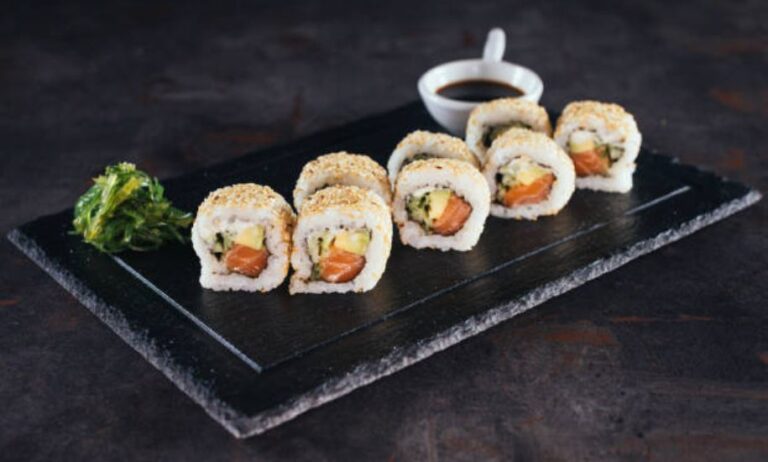Flavoryo presents an in-depth culinary guide to one of the most beloved sushi creations: the shrimp tempura roll. This unique dish blends crispy, golden-fried shrimp with cool, creamy textures, wrapped neatly in sushi rice and seaweed. From its origin to expert rolling techniques, this article covers everything you need to know about the shrimp tempura roll.
What Is Shrimp Tempura Roll?
The shrimp tempura roll is a sushi roll that features tempura-fried shrimp as its main filling. Unlike traditional raw fish sushi, this roll is ideal for those who prefer their seafood cooked. Typically, the roll includes other ingredients such as avocado and cucumber, and it’s often topped with sauces like spicy mayo or eel sauce. The contrast between the crunchy shrimp and the soft rice makes it especially appealing.
History and Origin of Shrimp Tempura Roll
The shrimp tempura roll finds its inspiration in Japanese cuisine but is a product of sushi’s global evolution. While tempura (batter-fried seafood or vegetables) has been part of Japanese food for centuries, combining it with sushi is more of a Western innovation. American sushi restaurants popularized the idea of using crispy shrimp inside sushi rolls to appeal to broader palates, especially among those hesitant about raw fish.
Main Ingredients in Shrimp Tempura Roll
Every shrimp tempura roll contains a harmonious blend of flavors and textures. Here’s what typically goes into making it:
-
Shrimp Tempura: Large shrimp, battered and deep-fried until golden and crispy.
-
Sushi Rice: Sticky rice seasoned with rice vinegar, sugar, and salt.
-
Nori: Seaweed sheets that hold the roll together.
-
Avocado: Adds creaminess to balance the crunch.
-
Cucumber: Offers a refreshing and crisp bite.
-
Sauces (Optional): Spicy mayo, eel sauce, or teriyaki glaze enhance flavor.
How to Make Shrimp Tempura Roll at Home
Making your own shrimp tempura roll is a rewarding experience. Here’s a simple breakdown of the preparation steps:
1. Prepare the Sushi Rice
Start by washing short-grain rice thoroughly. Cook it in a rice cooker and season it with a mixture of rice vinegar, sugar, and salt while it’s still warm. Let it cool to room temperature before using.
2. Make the Shrimp Tempura
Peel and devein large shrimp, leaving the tail on. Dust them lightly with flour, dip them into cold tempura batter, and fry until golden. Let them rest on paper towels to remove excess oil.
3. Arrange the Ingredients
Lay a sheet of nori on a bamboo mat. With wet hands, spread a thin layer of sushi rice over the nori. Flip it over so the rice faces down.
4. Add Fillings and Roll
Place shrimp tempura, avocado slices, and cucumber strips on the nori. Using the mat, roll tightly and evenly, sealing the edges by pressing gently.
5. Slice and Serve
Cut the roll into 6–8 bite-sized pieces with a sharp knife dipped in water. Plate with wasabi, pickled ginger, and soy sauce for dipping.
Variations of Shrimp Tempura Roll
One of the strengths of the shrimp tempura roll is its versatility. Here are some popular variations:
-
Spicy Shrimp Tempura Roll: Adds spicy mayo or sriracha for heat.
-
Dragon Roll: Topped with avocado slices and drizzled with eel sauce.
-
Crunch Roll: Finished with fried onion or panko crumbs on top.
-
Inside-Out Roll: Rice on the outside, often sprinkled with sesame seeds.
These twists enhance the original roll and allow for personalized flavor combinations.
Health and Nutrition Facts
While the shrimp tempura roll is delicious, it’s important to know its nutritional profile:
-
Calories: Each roll may contain 300–500 calories depending on size and ingredients.
-
Protein: Shrimp provides lean protein.
-
Carbs: Comes mainly from rice and vegetables.
-
Fat: Tempura frying adds fat, especially if sauces are used.
To make it lighter, consider air-frying the shrimp or reducing the rice quantity.
Why Shrimp Tempura Roll Is So Popular
The popularity of the shrimp tempura roll stems from its accessibility and appealing flavor profile. It caters to sushi beginners who might be hesitant about raw fish. The contrast between the crispy shrimp and the soft, seasoned rice creates a satisfying bite. Plus, the roll’s adaptability makes it a menu staple in sushi bars worldwide.
Tips for Perfecting Your Shrimp Tempura Roll
To make the best shrimp tempura roll at home or in a professional setting, consider these tips:
-
Use Cold Tempura Batter: Keeps the shrimp coating crisp and light.
-
Don’t Overfill the Roll: Too many ingredients will make it hard to roll and slice.
-
Keep Rice Sticky, Not Wet: Rinse rice well before cooking to remove excess starch.
-
Use a Sharp Knife: Clean the blade between cuts to ensure clean slices.
-
Roll Tightly and Evenly: Prevents the roll from falling apart.
With practice, you’ll be able to produce sushi rolls that look and taste restaurant-quality.
Serving Suggestions and Accompaniments
The shrimp tempura roll is commonly served with:
-
Soy Sauce: For dipping.
-
Pickled Ginger: To cleanse the palate between bites.
-
Wasabi: For a sharp kick.
-
Miso Soup or Edamame: Great side dishes that complement the roll.
Some even serve it with green tea or sake to complete the Japanese culinary experience.
Cultural Impact of Shrimp Tempura Roll
Though not a traditional Japanese dish, the shrimp tempura roll has become symbolic of sushi’s global popularity. It merges Japanese cooking techniques with Western preferences, making it a cultural crossover success. From sushi food trucks in the U.S. to upscale Japanese fusion restaurants in Europe, the shrimp tempura roll is a bridge between worlds, flavors, and people.
Final Thoughts
Whether you’re new to sushi or a seasoned fan, the shrimp tempura roll is a flavorful, texturally pleasing, and versatile choice. It’s easy enough to make at home and fancy enough to enjoy in a sushi restaurant. Its crispy, creamy, and savory elements make it one of the most beloved sushi variations globally.
